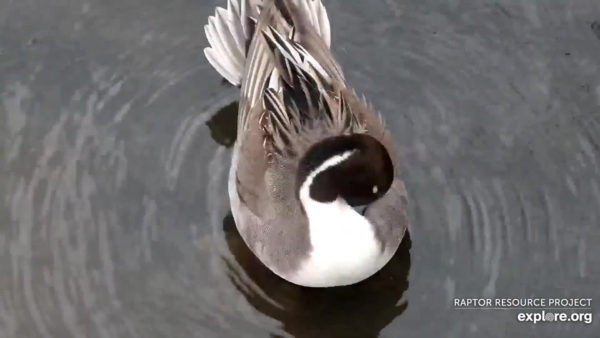Information About The Bird
Seen/Heard at
Mississippi River Flyway
Diet
Northern Pintails are omnivorous dabbling ducks. Their diet includes snails, clams, adult and larval aquatic and terrestrial invertebrates, seeds from aquatic plants, and grains like rice, wheat, corn, and barley. They pick at seeds and grains while walking or scoop up aquatic insects and seeds with their bills.
Dabbling ducks like Northern Pintails require shallow water to feed and raise young. Since they don’t dive, they are unable to feed in deep water, although they can forage on land. Diving ducks like Mergansers can feed in deep water, but have a hard time foraging on land. You can learn more about waterfowl feeding adaptations here: http://www.ducks.org/conservation/waterfowl-research-science/waterfowl-feeding-adaptations.
Nesting
Northern Pintails nest from early April through early August. Pairs make low flights over potential nesting areas before the female chooses a nesting spot. She builds a nest by dropping to the ground, digging with her feet, and rotating to create a shallow depression or scrape. Once her scrape is done, she pulls surrounding sedges, reeds, cattails, twigs, leaves, and other vegetation to build and line her nest. Three to four days after laying begins, she plucks down from her breast to cover and conceal her eggs.
Northern Pintails typically produce one clutch of three to twelve pale olive green eggs per year. Females incubate eggs for 22 to 24 days. and young leave the nest for the first time within 24 hours of hatch. Females attend their broods for about four to six weeks: males don’t incubate and rarely attend broods.
Citations and attributions
Ridgely, R.S., T.F. Allnutt, T. Brooks, D.K. McNicol, D.W. Mehlman, B.E. Young, and J.R. Zook. 2003.
Digital Distribution Maps of the Birds of the Western Hemisphere, version 1.0. NatureServe, Arlington, Virginia, USA. Data provided by NatureServe in collaboration with Robert Ridgely, James Zook, The Nature Conservancy – Migratory Bird Program, Conservation International – CABS, World Wildlife Fund – US, and Environment Canada – WILDSPACE.
Web Link: http://bit.ly/2ynPQ5I
The Cornell Lab of Ornithology Birds of North America: https://birdsna.org/Species-Account/bna/species/norpin/introduction
All About Birds: https://www.allaboutbirds.org/guide/Northern_Pintail/lifehistory
General Description
Migration
Measurements
Wing Design
| See also different: | Mississippi River Flyway |
